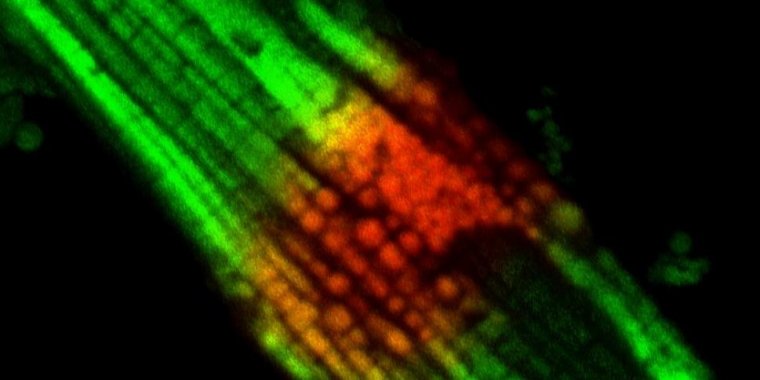| Health / Health News |
Researchers discover mitochondrial “circuit breaker” that protects heart from damage
A team of scientists from the National Institutes of Health has discovered biological mechanisms that appear to prevent damage to the heart muscle’s “power grid,” the network of mitochondrial circuits that provide energy to cells.

Microscopic image of mitochondria within a single heart cell. Mitochondria highlighted in red were exposed to ultraviolet light. ![]()
One of those mechanisms, the researchers found, acts much like a circuit breaker, allowing energy to continue moving throughout the heart muscle cells even when individual components of those cells—the mitochondria—have been damaged.
Such protective mechanisms could one day help better understand how heart and skeletal muscle function under both healthy and unhealthy conditions, such as with heart disease, mitochondrial diseases, and muscular dystrophy, the researchers say.
In 2015, members of this same NIH research team announced the discovery of the so-called mitochondrial power grid in the skeletal muscle. Since that pivotal discovery, some scientists have raised questions about how such a grid would protect itself from damage to the muscle cells. This new finding offers some key insights.
Using high-resolution 3D images and special light-activated probes, the scientists revealed a two-part system protecting the heart muscle’s power grid from disease-related damage.
Instead of being organized as one large, grid-like network such as in skeletal muscle, the mitochondrial circuits in the heart are arranged in parallel rows that form several smaller subnetworks, the researchers found.
This subnetwork acts as a mechanism to prevent damage by limiting the spread of electrical dysfunction to smaller regions.
The researchers compared the newly discovered circuit breaker mechanism to lightning striking a city power grid: Lights may flicker over the whole city, but once the circuit breaker activates, only part of the city loses power. (NIH)
YOU MAY ALSO LIKE





